
When I poured the sugar cane, then stir in a cup of hot tea, sometimes I imagine the government-owned sugar cane plantation's great profit in the period of Cultuurstelsel in Dutch Indies.
Now, the of colonial legacy was memorialized in an old sugar factory,
Suiker Fabriek Gondang Winangoen 1860, Klaten, Central Java.
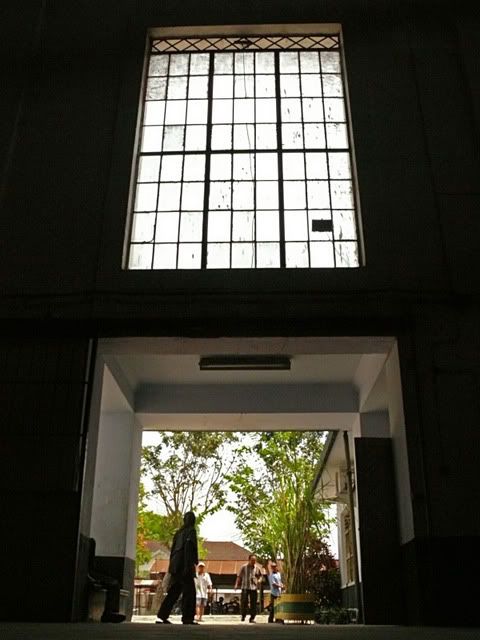
The Principal Gate of Gondang Winangoen Sugar Cane Factory 1860
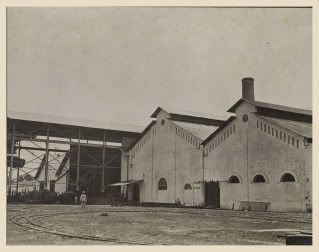
The Gondang Winangoen sugar cane factory - 1921
Source: KITLV
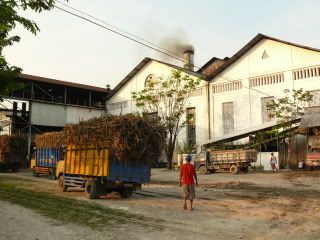
The Gondang Winangoen sugar cane factory - 2010
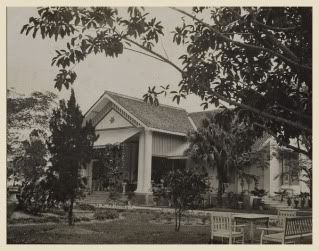
The Dutch officer house in 1921.
Built in the indische style in the end of 19th century.
See the tuscans column in portico and its base.
Source: KITLV
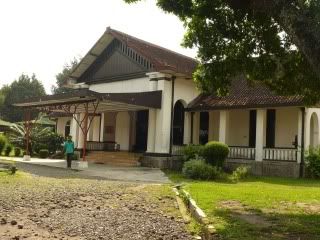
The Dutch officer house in present day.
The Sugar Cane Museum - Central Java since 11th of September 1982
ON MISSION
The Gondang Winangoen Suiker fabriek located at Jogja-Solo road, exactly at the Village Plawikan, Jogonalan District, Klaten Regency. Inside the factory area there are beautiful tropical houses built in 1930s, until now most still maintained and used as a sugar factory employee residence.
On 18th of August 2010, accompanied by Budi N. Dharmawan, we cruised that sugar factory which built in 1860. We want to tread the golden history of Gondang Winangoen Sugar Factory, feel the life an ambtenaar with overnight stay in a indische house which used administratuur in colonial era.
Fortunately, we came right on the milling season. Sip the sweetness of cane at Gondang Winangoen.
On 18th of August 2010, accompanied by Budi N. Dharmawan, we cruised that sugar factory which built in 1860. We want to tread the golden history of Gondang Winangoen Sugar Factory, feel the life an ambtenaar with overnight stay in a indische house which used administratuur in colonial era.
Fortunately, we came right on the milling season. Sip the sweetness of cane at Gondang Winangoen.
MAP OF KLATEN
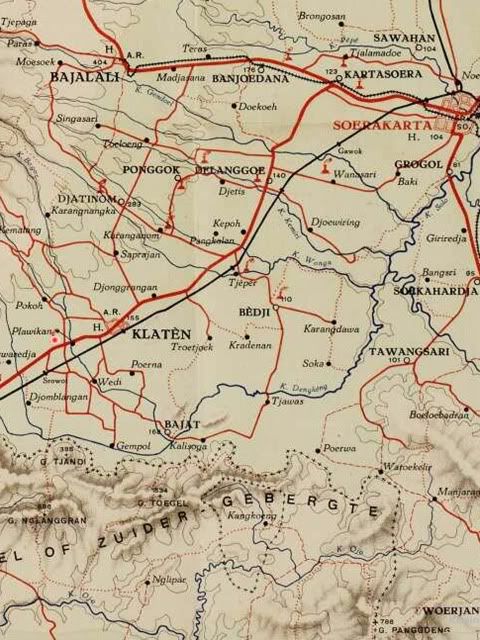
The red point is the location of Gondang Winangoen Suiker Fabriek
[Midden-Java]
“Semarang - Magelang - Jogjakarta – Soerakarta”
Published by het Officieele Toeristen Bureau
Batavia, 1925
Source:
Koninklijk Instituut voor de Tropen – Mauritskade 63, 1092 AD Amsterdam
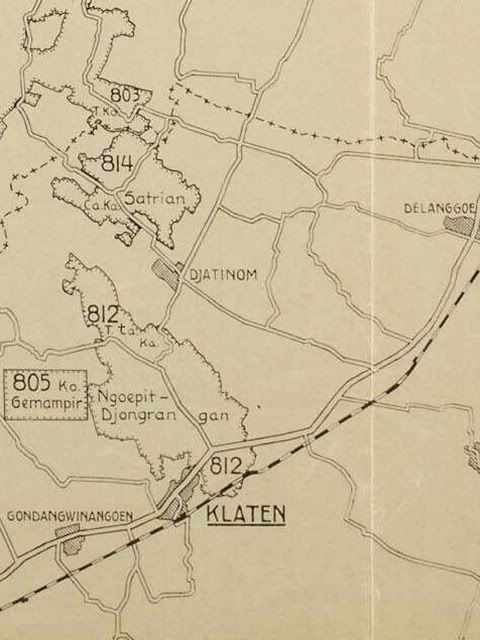
“Residentie Semarang en Djapara-Rembang, Kedoe, Klaten, Soerakarta, Madioen : voorloopige overzichtskaart van de bergcultuur ondernemingen”
vervaardigd door het geografisch instituut van de topografische dienst
Topografische dienst
Batavia, 1947
Source:
Koninklijk Instituut voor de Tropen – Mauritskade 63, 1092 AD Amsterdam
THE OLDEST MILLING MACHINE
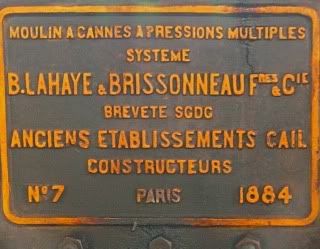

The red point is the location of Gondang Winangoen Suiker Fabriek
[Midden-Java]
“Semarang - Magelang - Jogjakarta – Soerakarta”
Published by het Officieele Toeristen Bureau
Batavia, 1925
Source:
Koninklijk Instituut voor de Tropen – Mauritskade 63, 1092 AD Amsterdam

“Residentie Semarang en Djapara-Rembang, Kedoe, Klaten, Soerakarta, Madioen : voorloopige overzichtskaart van de bergcultuur ondernemingen”
vervaardigd door het geografisch instituut van de topografische dienst
Topografische dienst
Batavia, 1947
Source:
Koninklijk Instituut voor de Tropen – Mauritskade 63, 1092 AD Amsterdam
THE OLDEST MILLING MACHINE

We amazed about the giant wheels, tubes, and pipes. As a satire novel in 18th century works of Jonathan Swift, we are like the Lilliputians in the Gulliver’s country. In the milling station, I found the inscription written on the machine with the French language ”Moulin A Cannes A Pressions Multiles Systeme B.Lahaye & Brissonneau F&C Brevete SGDG Anciens Establissements Cail Contructeurs No.7 Paris 1884”. It means the multiple systems sugar cane milling machines were made in France 1884, which identified the oldest engine of the many sugar factories in Indonesia.
CARBONATATION SYSTEM
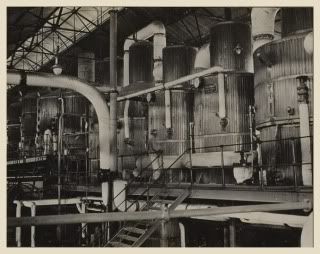
The Evaporation Station - 1921
Source: KITLV
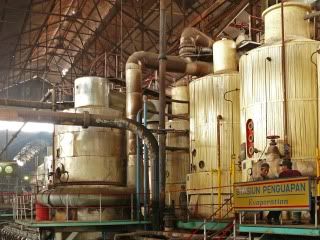
Evaporation Station - 2010

The Evaporation Station - 1921
Source: KITLV

Evaporation Station - 2010
After the “Purification Station”, the net sap flows into the pipes through the soared tubes in “Evaporation Station” to get the juice with a certain viscosity.
Uniquely, the purification process in Gondang Winangoen using double carbonatation system since Dutch Indies which does not exist in other sugar factories today. The carbonatation involves the introduction of milk of lime (calcium hydroxide suspension) and carbon dioxide enriched gas into the "raw juice" to form calcium carbonate and precipitate impurities that are then removed.
We amazed about the giant wheels, tubes, and pipes. As a satire novel in 18th century works of Jonathan Swift, we are like the Lilliputians in the Gulliver’s country.
Uniquely, the purification process in Gondang Winangoen using double carbonatation system since Dutch Indies which does not exist in other sugar factories today. The carbonatation involves the introduction of milk of lime (calcium hydroxide suspension) and carbon dioxide enriched gas into the "raw juice" to form calcium carbonate and precipitate impurities that are then removed.
We amazed about the giant wheels, tubes, and pipes. As a satire novel in 18th century works of Jonathan Swift, we are like the Lilliputians in the Gulliver’s country.
THE OLD LOCO OF
ORENSTEIN KOPPEL 1931
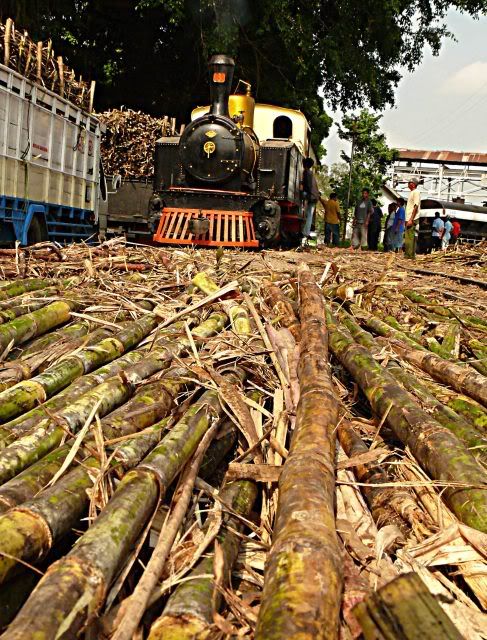
The "Gendismanis" - old loco from Orenstein Koppel 1931
This old locomotive had served in the Rendeng Sugar Factory in Kudus until 1998. "Initially used as a carrier of cane for about the 2 years in Gondang Winangoen. Name of Gendismanis inaugurated at a pre-milling ceremony in May 2010 ", said Bimo Satrio an employees of Gondang Winangoen Museum. After the conservation process since late 2009, now it is revitalized as the old locomotive train in Agrotourism of Gondang Winangoen.
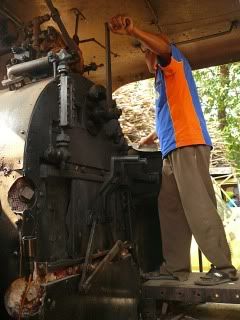
The Operator
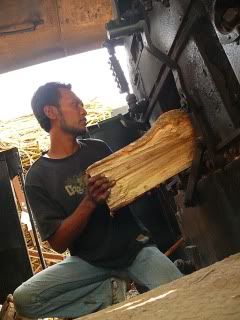
The Stoker
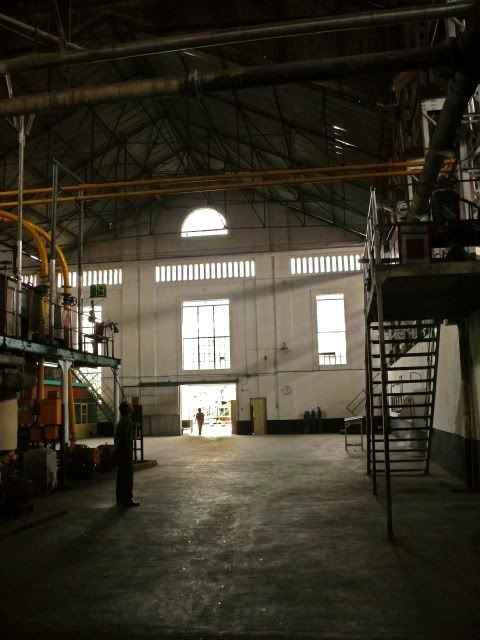
Inside the Sugar Cane Factory
HISTORICAL BACKGROUND
ORENSTEIN KOPPEL 1931

The "Gendismanis" - old loco from Orenstein Koppel 1931
This old locomotive had served in the Rendeng Sugar Factory in Kudus until 1998. "Initially used as a carrier of cane for about the 2 years in Gondang Winangoen. Name of Gendismanis inaugurated at a pre-milling ceremony in May 2010 ", said Bimo Satrio an employees of Gondang Winangoen Museum. After the conservation process since late 2009, now it is revitalized as the old locomotive train in Agrotourism of Gondang Winangoen.

The Operator

The Stoker

Inside the Sugar Cane Factory
HISTORICAL BACKGROUND
This plant was built by a trading company of NV Klatensche Cultuur Maatschappij in 1860, or ten years before the end of Cultuurstelsel (forced cultivation system). By coincidence, when the plant was built, ironically Eduard Douwes Dekker (pseudonym as Multatuli) published the book "Max Havelaar" which contains scathing criticism of the system of forced cultivation that shook the public.
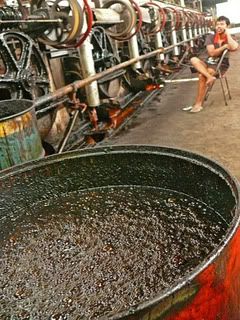
The Residuals
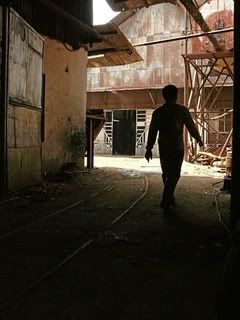
Unused Railway
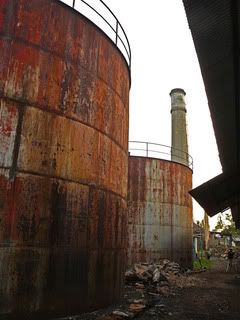
The Giant Tubes and Tower
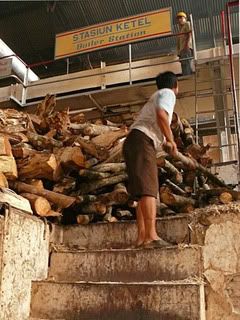
The Boiler Station
Labor works to supply the timber for cane manufacturing.

Without Ear Silencer
A worker who served as a guard engine is sitting relaxed, ignoring the noise of the engine roar that we think is deafening. "It is usual, it doesn’t matter", he said casually when I asked why not use the silencer for his ear.
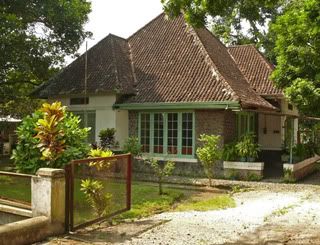
The Exotic House and Garden
Surrounding the sugar cane factory, there are many beautiful houses with tropical roof and cozy veranda built in 1930's.

The Residuals

Unused Railway

The Giant Tubes and Tower

The Boiler Station
Labor works to supply the timber for cane manufacturing.

Without Ear Silencer
A worker who served as a guard engine is sitting relaxed, ignoring the noise of the engine roar that we think is deafening. "It is usual, it doesn’t matter", he said casually when I asked why not use the silencer for his ear.

The Exotic House and Garden
Surrounding the sugar cane factory, there are many beautiful houses with tropical roof and cozy veranda built in 1930's.
ADMINISTRATUUR HUIS
We spent a night in this old mansion, called "Rumah Besaran". It is a former house of administrator in colonial era. Sitting on the veranda, pouring tea and sugar, then stir. Now the show is no longer the bitter forced cultivation system more than 150 years ago. Without intend to forget the history, the sweetness of the colonial legacy made an impression on tongue and heart, until now.
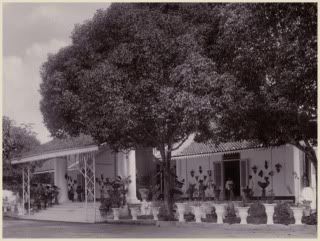
Administratuur huis - 1921
Built in Indische style in the end of 19th century.
Source: KITLV
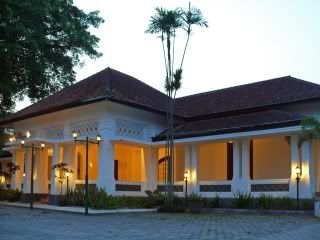
Adminitratuur huis - 2010
Probably, this house was renovated in the 1930's. The facade of this house was improved by new modern style, an art deco style which more simple in its facade.
***
See a whole this story in
National Geographic Traveler - Indonesian Edition
November-December 2010

Administratuur huis - 1921
Built in Indische style in the end of 19th century.
Source: KITLV

Adminitratuur huis - 2010
Probably, this house was renovated in the 1930's. The facade of this house was improved by new modern style, an art deco style which more simple in its facade.
***
See a whole this story in
National Geographic Traveler - Indonesian Edition
November-December 2010
Lori ini khusus buat wisatawan ya ? Bisa langsung beli karcis atau harus janji dulu dengan pihak pabrik gula ?
ReplyDeletehm..mungkin ini yg ada di dlm ceritanya pak Pramoedya ya....
ReplyDeleteIyah untuk wisata. Harus janjian dulu dengan pabrik gulanya Pak. soalnya mereka perlu mempersiapkan kayu-kayunya dulu untuk memanaskan ketel loko.
ReplyDeleteCerita yang mana ya mbak?
ReplyDeletewah detailnya aku lupa dik, pokoknya ada deh cerita ttg pabrik2 gula disekitar klaten jaman dulu....
ReplyDeleteAha! Anak Semua Bangsa, ya mbak? ;-)
ReplyDeletehe..he..kaya'nya, pokoknya salah satu dr 'tetralogie'nya deh....
ReplyDeleteSaya inget karena cover Anak Semua Bangsa versi Hasta Mitra bergambar pabrik gula.
ReplyDeleteini masuk NG edisi berapa ya :)
ReplyDeletemas yoan naek kereta api ini ya
ReplyDeleteStok lama sih hehehe. NG Traveler edisi November-Desember 2010
ReplyDeleteMenjelajah Istimewa Jawa dengan Kereta.
Iyah, jelang penggilingan turun buat motret-motret :)
ReplyDeleteMahandis,
ReplyDeletemkassi 4 this very nice explanation ,it gives me a vieuw how my mother in law lived at a sugar fabric,her brother now 101 years old is still living in Holland, he worked also there. They lived at Kebun Agung in the neighbourhood of Malang,also another aunt lived,near by, and an uncle worked in a sugar cane fabric at Medari. I am glad the indonesian people still use evereything to make the sugar,and all the buildings are in verey well state!...greetings from Europe, at the moment we are in Spain and in March we will be back in the Netherlands.have a nice day there!
greetings Cornelia.
Hi Cornelia
ReplyDeleteThanks for visiting my post.
Your ancestor live in sugar cane factory also. It's great if you travel to some sugar cane factories in Java. It will be a remarkable adventure for viewing the past and present.
have a nice traveling!
:)
sadis jam kerjanya ampe 3 shift, 24 jam dong pabriknya beroperasi
ReplyDeleteLama tak menyambangi MP, tiba-tiba disambut hangat dengan kehadiran artikel ini. Thanks :)
ReplyDeleteNgga sadis kok.
ReplyDeleteJustru di musim giling yang berlangsung 3 bulan ini para buruh mendapatkan berkah upah lembur.
Memang selama musim giling pabrik beroperasi 24 jam, antrian truk pengangkut tebu juga selalu mengular sampai jalan raya Jogja-Solo.
saya juga sudah tidak posting foto selama lebih dari setahun!
ReplyDeletetiba-tiba disambut hangat juga oleh warga2 MP lama.
welcome :)
masih produksi to sampai sekarang?
ReplyDeleteHehehe..masih mam....
ReplyDeleteproduksi sempet terbengkalai karena tahun lalu lumayan padat kegiatannya :)
Apakah mama oen berminat jadi produsernya? :p
whuahahahahaha...... duwit saka ngendi.....
ReplyDeletetak kirain di gondang itu cuman museum gula aja lho. ternyata masih 'giling' to....
Nice to see you again here ... :)
ReplyDeleteIt's amazing how those machines still work today ...
ReplyDeletemanually operated?
ReplyDeletehehe... something made in Europe is somehow better than one made in China ...
ReplyDeletewow.... I wonder how it sounds ...
ReplyDeletemaklum laah.... penganten baru :D
ReplyDeletemmm... ternyata bukan cuma arsitek yg jam kerjanya sampe pagi ...
ReplyDeletemaklum lah... penganten baru :D
ReplyDeleteWah, manteb....
ReplyDeleteBung Mahandis... foto2 rumahnya yang banyak dong... :) Saya tertarik lihat arsitektur rumah2 tahun 30-an itu... Trims.
view fotonya sengaja disamakan dengan foto KLTV atau gak sengaja sama gitu ?
ReplyDeleteMasa sih? hehehehe...
ReplyDeleteDulu orang-orang cina banyak pengaruhnya kala membangun rumah dan kantor di Batavia lho.
It was identified the oldest engine of the many sugar factories in Indonesia!
ReplyDeleteA few parts of these machines.
ReplyDeleteFire extinguisher's sounds: sssrrrrrrrhhhhhzzzz... sssrrrrrrrhhhhhzzzz...
ReplyDeleteBell's sounds: tanggg...tanggg... tanggg...
still wonder? :D
cur-col nih ;-)
ReplyDeletearsitek mirip2 buruh juga, mereka manusia juga.
Wah boleh-boleh. Memang benar rumahnya masih cakeb-cakeb di sana :)
ReplyDeleteThanks.
Justru karena penganten baru ini malah semangat nge-blog lagi hehehe... :D
ReplyDeleteAjaib! Ngga sengaja sama. baru kemaren liat2 kitlv eh ada angle yang sama persis...
ReplyDeleteSee you again bro! Thanks for dropping some comments.
ReplyDeleteMasih giling, meski tak sesering dulu lagi. Maklum lahan tebu semangkin sempit karena terberangus pemukiman dan petani lebih tertarik menanam padi. Belum lagi banjirnya gula-gula impor yang mencukupi gap antara konsumsi dan produksi domestik.
ReplyDeleteWeizzz..jadi juga akhirnya re-build Orenstien ini. Matur nuwun informasinya, mas Yoan. Mudah2an pertengahan tahun ini sempat mampir ke Klaten lagi dan nyobain locomotive nan yahud ini..... :)
ReplyDelete2 timbangan merk Van Berkel di belakang orang2 ini selalu membuatku termehek-mehek, ngiler.... :)
ReplyDeleteMantab, bisa dapet dua foto yang sama :)
ReplyDeleteDear, pabrik Gulaku yang di lampung itu pabrik lama atau baru ya?
ReplyDeleteWah ada acara pulang kampung nih pak tigun. mau sekalian buka cabang kedai kopi di Jawa?
ReplyDeleteLoko Orenstein ini usai konservasi 2010 diberi nama "Gendismanis". Selamat berkoelilieng te suiker fabriek Gondang Winangoen!
Wah memang kalo di inggris sudah masuk museum The Avery Historical Museum.
ReplyDeleteBtw mereknya Avery Berkel bukan van Berkel sepertinya pak.
Tentu mantab.
ReplyDeleteMakananannya sih biasa, tapi sapa dulu donk chef-nya ;-)
Itu pabrik baru milik PT Sugar Group Companies (PT Gula Putih Mataram, PT Sweet Indo Lampung, dan PT Indo Lampung Perkasa).
ReplyDeleteLha pabrik tertua di Lampung PT Gunung Madu Plantation aja baru beroperasi 1975 dear.
waah...the return of (mas)Yoan , dengan artikel terbarunya ;))...telat nih, ternyata sudah banyak yang dateng
ReplyDeletereturn of fitri juga hehe :D
ReplyDeleteHengelo und Stork---, PT. Boma Bisma Indra & PT. Barata yang membuat mesin2 ini tetap survive..hebat gak Indonesia..........
ReplyDeletesemuanya di pabrik gula rata-rata masih manual, tetapi tidak berarti yang kuno itu tidak mumpuni, karena masih diperlukan Feeling yang jagoan untuk "menurunkan" gula (istilahnya) dalam proses pemasakan kristal gula pasir
ReplyDeletetaun segitu udah udah variable presurre
ReplyDeletegilingannya heheheheee, belum PLC (Programbale Logic Control),,,,,
Wuih...karbonatasi......, sistem yg menghasilkan gula super putih (kalo operator kerjanya benar), cuma mahal diongkos dibandingkan Sulfitasi
ReplyDeleteford 3600/6600 gak ada matinya tuh tractor hehehhee
ReplyDeleteOrang Keuangan di pabrik gula : - Perokok Berat, kepala TUK warna tinta Penanya Harus Hijau, ngitungnya pake kalkulator atau mesin hitung Facit.heheheheh
ReplyDeletebuset dah..ngebal ampas sambil merokok, kalo terbakar bisa seminggu baru padam........geblek.....nyusahin bagian pmk (kalo ada)
ReplyDeletekebayang malesnya kalo tengah malam pengen ke belakang......hehehe
ReplyDeleteWah hebat bisa tahu sampai tukang servisnya!
ReplyDeletemembuat gula pasir bak pekerjaan seniman ya? hehe...
ReplyDeleteKenapa harus bertinta hijau?
ReplyDeleteSepertinya di ruangan itu ada juga mesin hitung facit buatan swedia.
Iya nih, tidak menuruti prosedur operasi standar hehe
ReplyDeleteBenar. Kamar yang saya tempati kira-kira berukuran 9m x 3m. Kalau mau ke kamar mandi harus keluar kamar dulu.
ReplyDeleteFoto-fotonya semanis gula Gondang..:-).Selalu kagum dengan foto-foto Yoan!
ReplyDeleteHaha...mas dion bisa ajah.
ReplyDeleteSelamat bertualang di Great Britain mas! Titip liputan [pabrik gula di sana kalo ada :)
Thx.
untuk keamanan bukti kas baik masuk/ keluar mas..... , setiap kepala bagian warna tintanya beda ada yg biru, merah, hijau,......dan harus tinta cair...tapi gak tau kalau sekarang.......kayakna udah mulai acak-acakan..heheh kadang2 bos saya saja pinjam ballpoint saya kok..walah jaannn....,
ReplyDeleteoepas > KP (Keamanan Perusahaan) > SATPAM, orang yang paling saya takuti (walaupun dulu saya anak PG).....kalau ketahuan ngambil tebu hihihih.....
ReplyDeletewah....komplit dan fantastic mas....
ReplyDeleteSip thanks Pak.
ReplyDeleteMasih berkeinginan buat eksplorasi pabrik-pabrik gula seantero Jawa nih.
great pics & history mas yoan :) setelah benteng2, sekarang lg hunting pabrik2 gula neh.
ReplyDeletehehe ternyata seru juga di pabrik gula mbak :)
ReplyDeletethanks...
Wah..di sini ga ada pabrik gula...he..he...
ReplyDeleteTrus Inggris dapet gula dari mana?
ReplyDeletekeren..keren...
ReplyDeleteKalo ndak salah bukannya Anak semua bangsa banyak mengambil setting Pabrik Gula Tulangan, Sidoarjo ?
ReplyDeletemantaff paman...........terus berjuang untuk perekonomian agraris..................semoga sukses selalu dan terus mau menjaga cagar budaya di klaten.
ReplyDeleteAnda mungkin menjadi orang terakhir yang berkomentar di blog ini, sebelum multiply tutup, mas :)
ReplyDeleteTerima kasih.